Over 1.106.000 registered users (EN+CZ).
AutoCAD tips, Inventor tips, Revit tips, Civil tips, Fusion tips.
Try the new precise Engineering calculator.
New AutoCAD 2026 commands and sys.variables and env.variables,.
 Discussion forum
Discussion forum
?CAD discussions, advices, exchange of experience
 CAD discussion forum - ask any CAD-related questions here, share your CAD knowledge on AutoCAD, Inventor, Revit and other Autodesk software with your peers from all over the world. To start a new topic, choose an appropriate forum.
CAD discussion forum - ask any CAD-related questions here, share your CAD knowledge on AutoCAD, Inventor, Revit and other Autodesk software with your peers from all over the world. To start a new topic, choose an appropriate forum.
Please abide by the rules of this forum.
This is a peer-to-peer forum. The forum doesn't replace the official direct technical support provided by ARKANCE for its customers.
How to post questions: register or login, go to the specific forum and click the NEW TOPIC button.
|
Post Reply 
|
| Author | |
LTunlimited RSS 
RSS robots 
Joined: 23.Nov.2009 Status: Offline Points: 368 |
 Topic: Transparent Commands Topic: Transparent CommandsPosted: 07.Jan.2011 at 10:38 |
|
This post isn’t about the new transparency for objects and layer introduced in AutoCAD LT 2011. Instead, it’s about using commands transparently – as in, inside other commands. Transparent commands enable you to make changes or get information without pausing the current command. To make a command transparent, simply prefix it with an apostrophe (‘) if you’re typing at the command line, or just select it from the ribbon. If you choose a command that can’t be used transparently, one of two things will happen. If you picked it from the ribbon, your first command will be canceled and you’ll find yourself in the second command. If you typed it at the command line, you’ll get this message: ** That command may not be invoked transparently ** So, what commands can be used transparently? Here’s a list (this may not be exhaustive; if you find more let me know): ABOUT APERTURE ATTDISP CAL COLOR DIST ELEV GRAPHSCR GRID HELP ID LAYER LIMITS LINETYPE MATCHPROP OBJECTSCALE OSNAP REDRAW SCRIPT SETVAR SNAP SPELL STYLE ZOOM And some examples for using transparent commands? Let’s say you started to draw a line, but realized you were on the wrong layer. Before picking your second point, just go up to the ribbon and change the layer from the pulldown. OR, type –layer to open the Layer Properties Manager and make your changes there. What if, in drawing that same line, you remembered that it was supposed to be the same length as another line…but you forgot exactly how long? Before picking your second point, type –dist and measure the first line, then enter the result for your new line. Zoom is probably the handiest transparent command, and you probably use it transparently every day without even thinking about it, because zooming and panning with the mouse wheel is transparent by default.
Go to the original post... |
|
|
LT Unlimited - Autodesk blog by Kate Morrical
|
|
 |
|
Post Reply 
|
|
|
Tweet
|
| Forum Jump | Forum Permissions  You cannot post new topics in this forum You cannot reply to topics in this forum You cannot delete your posts in this forum You cannot edit your posts in this forum You cannot create polls in this forum You cannot vote in polls in this forum |
This page was generated in 0,107 seconds.
![CAD Forum - tips, tricks, discussion and utilities for AutoCAD, Inventor, Revit and other Autodesk products [www.cadforum.cz] CAD Forum - tips, tricks, discussion and utilities for AutoCAD, Inventor, Revit and other Autodesk products [www.cadforum.cz]](/common/arkance_186.png)









 Transparent Commands
Transparent Commands Topic Options
Topic Options


